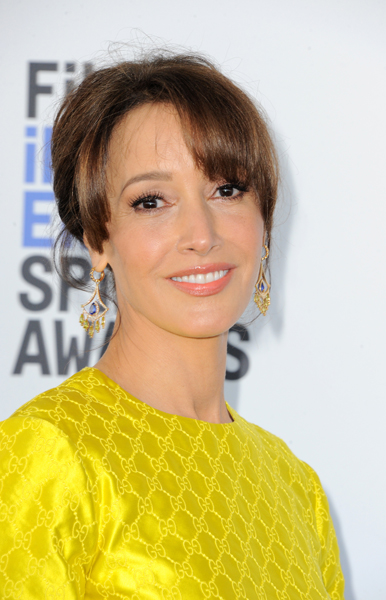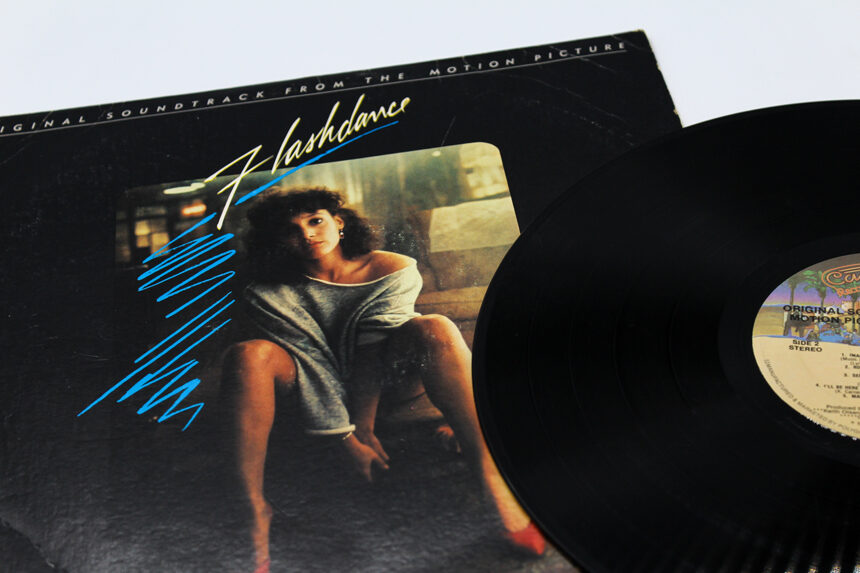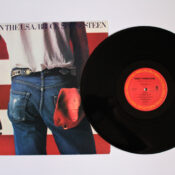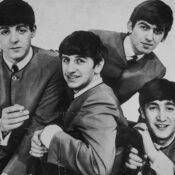Some films are made in their decade, and some films make their decade. Just as Blackboard Jungle became inextricably linked with rock and roll in movies and Saturday Night Fever took disco culture to the masses, one film codified a number of sensibilities (and future clichés) that would forever be associated with “The ’80s.” Released 40 years ago this week, Flashdance was created by a production partnership that would define Hollywood for the rest of the decade while also having major impacts on fashion, music, and yes, dance.
The genesis of the film came from a concept that screenwriter Thomas Hedley sold in 1980; he based the script on the true story of Maureen Marder, who worked construction by day and was an exotic dancer in Toronto by night. The British magazine editor and writer saw four of his screenplays get produced between 1980 and 1982, but Flashdance would have to wait as it changed hands between original buyer Casablanca (who plunked down $300,000 plus 5 percent of the net for the rights) and its eventual production house, Paramount Pictures. Along the way, additional contributions were made to the script by Joe Eszterhas; Eszterhas would spend the next two decades getting increasingly bigger paychecks for screenplays like the sexually-charged thrillers Basic Instinct and Jade and legendary bad movie Showgirls.
The producing duo that would eventually get Flashdance on screen would set the tone for the rest of the 1980s. Don Simpson and Jerry Bruckheimer were friends with established Hollywood experience. Simpson had already worked as a production vice-president and president (and had been fired from) Paramount, and Bruckheimer had notched some success producing films like 1980’s American Gigolo. The pair decided to become an official team and took Flashdance on, hiring Adrian Lyne to direct. Lyne had experience in commercials and had one feature under his belt, the 1980 coming-of-age drama Foxes, which starred Jodie Foster.
Flashdance original trailer (Uploaded to YouTube by Rotten Tomatoes Classic Trailers)
Flashdance’s story struck many as implausible, despite its real-life origins, but Simpson and Bruckheimer saw the potential in its feel-good elements. The screenplay follows Alex, a young woman who dreams of being a ballerina but supports herself as a steelworker while also dancing at a cabaret. Yale student Jennifer Beals landed the role, but she wouldn’t be the only person performing as Alex; three other performers made significant contributions to the dancing in the film. French actress Marine Jahan doubled for Beals in several scenes, while two specific moves were created by male dancer Crazy Legs (the breakdance moves during the climactic audition) and gymnast Sharon Shapiro, a U.S. National Champion at vault (the aerial move in the final sequence).
“Flashdance…What a Feeling” (Uploaded to YouTube by UnidiscMusic)
An obviously critical part of the film would be the music. Since Flashdance wasn’t a traditional movie musical (where performers would sing and dance the material), Lyne took the novel approach of incorporating the visual style of music videos that had been popularized in America by the 1981 advent of MTV. His heavy use of shadows, stylized lighting, and clever editing deftly concealed the fact that doubles were dancing in addition to Beals. With a contemporary look, the film had to also sound contemporary. The score came from Giorgio Moroder, the Italian “Father of Disco” who was legendary as a composer and producer of dance music; he also wrote the music for the main song of the film, “Flashdance…What a Feeling.” The lyrics were written by drummer/producer Keith Forsey and the song’s performer, Irene Cara. Cara was sort of a movie music good luck charm, having already dropped a #4 U.S. hit with the Academy Award-winning title track to Fame. Another major tune was Michael Sembello’s “Maniac,” a song originally inspired by a serial killer; Lyne loved the music of the original, so Sembello rewrote the bulk of the lyrics to fit the film.
When Flashdance hit theaters 40 years ago this week, many reviewers were less than kind. Though a number of critics, like Roger Ebert, singled out Beals for praise, a rather large number of writers dumped on the story and style. That had absolutely no effect on audiences, as the oddball dance film with a $7 million budget would go on to pull in more than $200 million at the worldwide box office. In the U.S., it finished as the third-highest grossing film of 1983, behind only Terms of Endearment (#2) and a tiny little art-house project called (what was it? Oh, yeah) Return of the Jedi.
“Maniac” by Michael Sembello (Uploaded to YouTube by ClassicVideos80s)
Music from the movie was massive. In a year that saw songs like “Every Breath You Take,” “Billie Jean,” “Come On Eileen,” “Beat It,” and “Total Eclipse of the Heart” take turns at number one, “Flashdance…What a Feeling” held the top spot for six consecutive weeks, reigning from May 28 to July 2, and “Maniac” was #1 for two additional weeks. “Flashdance…What a Feeling” was a veritable awards monster: Cara earned a Grammy for Best Pop Vocal Performance, Female, and the song took both the Academy Award and the Golden Globe for Best Song. Just this year, it was preserved in the National Recording Registry by the Library of Congress.
Along with the music and visuals, the movie was influential for a number of outfits that Alex/Beals wore. The film’s poster featured an iconic off-the-shoulder sweatshirt that was based on a modification that Beals made to her own clothes. After her favorite shirt of a similar style had shrunk in the wash, she cut the headhole wider so it would still fit. When she wore the shirt to a wardrobe fitting for the film, Lyne was crazy for the look. The wardrobe department designed a new top to reflect the style, and it wound up on the movie’s poster. The asymmetrical off-the-shoulder trend became an ’80s staple, as did the signature leg warmers that Beals sports in several scenes.
Footloose trailer (Uploaded to YouTube by Rotten Tomatoes Classic Trailers)
Flashdance had an immediate impact on the look and sound of the movies. Lyne’s method of making certain scenes function as modular music videos that could be pulled out and put right on MTV was widely imitated, notably in the following year’s Footloose (which, wouldn’t you know it, also came from Paramount). Simpson and Bruckheimer would apply their fast-moving, pop music-infused, MTV-influenced style to a string of hit films, notably Beverly Hills Cop, Top Gun, Days of Thunder, Bad Boys, Dangerous Minds, and The Rock.
The famously hard-living Simpson died in 1996, but Bruckheimer continued to build on their success. He has shepherded a truly stunning line-up of movies, including the Pirates of the Caribbean franchise, the Bad Boys franchise, the National Treasure franchise, and individual films like Black Hawk Down, Armageddon, and Remember the Titans. On TV, he’s the driving force behind the CSI franchise and the massively successful reality competition series The Amazing Race.
Director Adrian Lyne went to make a number of zeitgeist-rattling films, notably 9-1/2 Weeks, Fatal Attraction, the widely acclaimed horror film Jacob’s Ladder, and Indecent Proposal. His 2002 film, Unfaithful, netted an Academy Award nomination for Diane Lane. And just last year, he returned to directing after a two-decade absence for Deep Water, which stars Ben Affleck and Ana de Armas.

For her part, Beals completed her studies at Yale and continues to work in film and television and as an acclaimed photographer. She won an NAACP Image Award for Outstanding Actress in a Motion Picture for Flashdance (which actually surprised some people at the time, as they didn’t realize that she was biracial) and received critical praise for her work on The L Word (2004-2009) and its spin-off, The L Word: Generation Q (2019-2023). In fact, Beals has been extremely visible and busy in the past two years; in addition to Generation Q, she has had recurring roles on NBC’s Law & Order: Organized Crime and the Disney+ Star Wars series, The Book of Boba Fett.
Forty years on, Flashdance has stuck around in popular consciousness through its visuals and its sound. It’s a fair bet that the title song (which never actually utters the world “flashdance”) will stick around as long as there are ’80s playlists. Simpson and Bruckheimer’s legacy includes enormously popular films that not only resonate, but can still conquer the box office (see: Top Gun: Maverick). And Beals emerged as a strong talent with an enduring career. It might not have been regarded as a “great movie,” but it was certainly influential and a prime example of — it has to be said — taking your passion and making it happen.
Become a Saturday Evening Post member and enjoy unlimited access. Subscribe now




Comments
‘Flashdance’ had all the right elements at the right time, and were combined perfectly. I do feel ‘American Gigolo’ helped pave the way even before MTV. ‘Gigolo’ was one of the movie trailers (late 1979) before before ‘The Rose’, and I remember being shocked and mesmerized at the style, class and most of all, the music.
‘Call Me’. Giorgio Moroder’s masterpiece was used throughout the film in all kinds of versions aside from Blondie’s, to fit the moods of what was going on in the different sections. Truthfully, the film wasn’t all that great, but made up for it with such great music and style, that it really didn’t matter. This was an ’80s film before the decade even started. No ties to the tired-out, slovenly ’70s at all.
Another film that wasn’t really that good, but made up for it with style, scenery (and mostly Faye Dunaway) was ‘The Thomas Crown Affair’ from 1968. Unfortunately, it didn’t have positive style influence of ‘Gigolo’—at all. It’s no wonder ‘Flashdance’ was so amazing 3 years later, but across the board. It had all of the positive elements of ‘Gigolo’ in terms of style and Moroder’s music, but with a really good story as its foundation
Jennifer Beals herself was the heart and soul of the film. The rest was secondary to that. ‘Footloose’ was another great film that had style, fun, great music and substance to it. Most of Adrian Lyne’s films otherwise not so much, except for ‘Fatal Attraction’.
Jerry Bruckheimer’s mainly produced a lot of sell out junk, but when he’s good he’s really good; especially in television. ‘Cold Case’ (2003-2010) was a brilliant crime series, fusing the distant past with the present solving long ago crimes. It had to have been very expensive to produce. Matching the people, cars, backgrounds of 1956, then switching to 2006 again through the hour, was no easy thing. A very rare example of real, legitimate special effects necessary for a story you had to pay attention to.